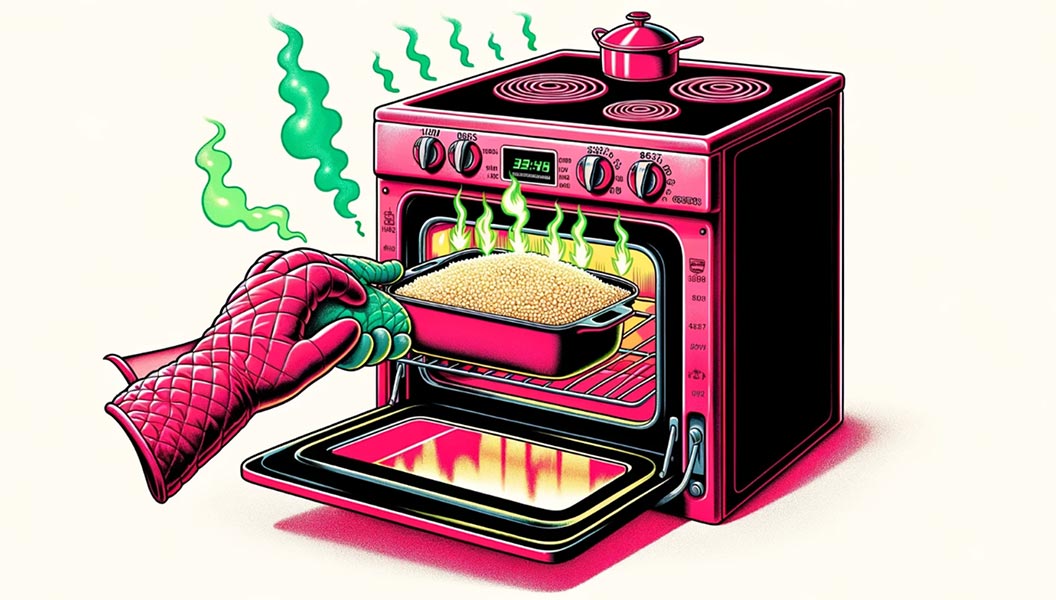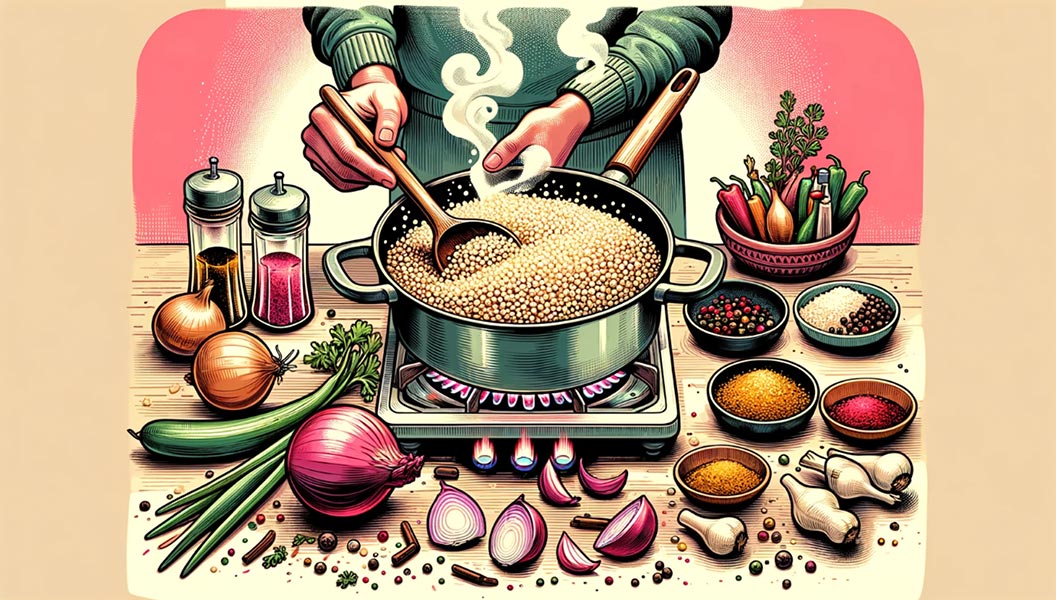Couscous is a traditional North African dish and also a staple pantry ingredient for Middle Eastern and Mediterranean diets. Couscous is a convenient option that can be easily prepared using either the microwave or stovetop. Its small granules can rapidly absorb hot water, resulting in a delightful, fluffy dish. It's the convenient base for any number of great side dishes.
But what is couscous? Is it a regional grain, like bulgur, rice, or farro? Or is it pasta? Although couscous looks and acts like a grain, it's made from semolina flour by crushing durum wheat; therefore, it's more like pasta. However, for most types of couscous, the cooking method is similar to rice. It is used as a main dish for a flavorful dish, cold salads, or added to soups and stews.
Cooking couscous is a straightforward process, yet achieving that perfectly fluffy texture involves a few key techniques. In this guide, I will show you step-by-step how to cook perfectly fluffy couscous and ways to cook couscous.
How To Cook Couscous On Stovetop

Ingredients & Tools
1 cup of dry couscous
1 ½ cups of water (vegetable broth or chicken broth works too)
1 tablespoon of extra virgin olive oil
½ teaspoon of salt (adjust to taste)
Optional: herbs, spices, vegetables, lemon juice, or your favorite protein
Medium pot or saucepan with a lid
Fork
Serving dish
Directions
- In a medium pot or saucepan, bring the water or vegetable broth with a drizzle of oil and a pinch of salt to a boil.
- Place the uncooked couscous into the boiling water and stir it gently. Gently incorporate the couscous into the boiling liquid, stirring it to ensure even distribution throughout. If you're using larger grains or whole wheat couscous, you may want to let it simmer for a minute or two.
- Cover the saucepan with a lid and let the couscous sit undisturbed for about 5 to 10 minutes, allowing it to absorb the hot liquid and become tender. It's important to refer to the package instructions for guidance, as the specific cooking time will vary based on the type of couscous you are using.
- Once the resting time has passed, uncover the couscous and use a fork to fluff the grains, separating them gently. This helps separate the grains, prevent clumping, and transfer them to a serving platter.
- Taste the cooked couscous and adjust the seasoning with salt or any other desired herbs and spices.
- At this point, your couscous can be enjoyed as a delightful side dish, incorporated into refreshing salads, or utilized as a versatile base for a wide range of recipes. The choice is yours!
How To Cook Couscous In Microwave

Ingredients & Tools
1 cup of couscous
1 1/2 cups of water or broth (for extra flavor)
A pinch of salt (optional)
Microwave-safe bowl
Fork or whisk
Cling film or a microwave-safe cover
Directions
- Measure the desired amount of couscous and place it in a microwave-safe bowl. The general ratio is 1 cup of couscous to 1 1/2 cups of water or broth, but adjust the amount according to your needs. For added flavor, you can use chicken, vegetable, or beef broth. If you're using water and want to enhance the taste of the couscous, add a pinch of salt.
- Add the appropriate amount of water or broth to the bowl. You can also season the liquid with salt or other spices if desired.
- Cover the bowl with a microwave-safe lid or microwave-safe wrap, leaving a small vent for steam to escape.
- Put the bowl in the microwave and set it to cook on high power for a duration of 2-3 minutes or until the water has been absorbed and the couscous is tender.
- After cooking, carefully remove the bowl from the microwave (it will be hot). Let it sit covered and rest for an additional 2-3 minutes. This resting period helps the couscous to finish steaming and become perfectly fluffy.
- Once the resting time has elapsed, uncover the bowl and use a fork to fluff the couscous gently, ensuring that the grains are separated. Then, transfer to a large bowl and adjust the seasoning with salt or any other desired dried or fresh herbs and spices.
How To Cook Couscous In Oven

Ingredients & Tools
1 cup of couscous
1 1/2 cups of boiling water or broth (for extra flavor)
A pinch of salt (optional)
1 tablespoon of olive oil or butter (optional for richness)
Oven-safe dish with a lid or aluminum foil
Fork
Directions
- Preheat your oven to around 350°F (180°C).
- Combine the desired amount of couscous with water or broth in a baking dish or oven-safe casserole dish.
- Enhance the couscous mixture by adding your preferred seasonings, including salt, pepper, herbs, or spices, to suit your taste. For added flavor and texture, consider incorporating chopped vegetables or dried fruits as well.
- Thoroughly stir the couscous mixture to ensure that all the grains are evenly coated and well-distributed throughout.
- Securely cover the baking dish with either foil or an oven-safe lid, ensuring a tight seal to trap the steam and moisture inside.
- Place the dish in the preheated oven and bake for approximately 20-25 minutes, or until the liquid is absorbed and the couscous becomes tender. Keep an eye on it, as the exact cooking time may vary based on the type and size of couscous you're using.
- Once cooked, remove the dish from the oven and let it rest for 5 minutes, still covered, to allow the couscous to fluff up and absorb any remaining moisture.
- Uncover the dish and fluff with a fork to separate the couscous grains. Take a moment to taste the couscous and make any necessary adjustments to the seasoning according to your preference.
How To Cook Couscous Pilaf Method

Ingredients & Tools
1 cup of couscous
1 1/2 to 2 cups of chicken, vegetable broth, or water
1-2 tablespoons of olive oil or butter
1 small onion, finely chopped (optional)
1-2 cloves of garlic, minced (optional)
Salt and pepper to taste
A medium-sized saucepan with a tight-fitting lid
Fork or spoon for fluffing and stirring
Directions
- Heat a small amount of oil or butter in a saucepan over medium heat.
- Add the couscous to the saucepan and stir it gently for a couple of minutes until it becomes lightly toasted and golden brown. This step elevates the couscous's flavor profile, enhancing its overall taste and enjoyment.
- Pour in water or broth, using a ratio of approximately 1 1/2 cups of liquid for every 1 cup of couscous. You can adjust the quantity based on your preference.
- After bringing the liquid to a boil, lower the heat to low and cover the saucepan with a lid to trap the steam. Allow the couscous to simmer for approximately 10-15 minutes or until all the liquid has been absorbed. To ensure it reaches your preferred tenderness, you can refer to the package instructions or taste a few grains of couscous. Adjust the cooking time if needed.
- Once all the liquid has been absorbed, remove the saucepan from the heat and let it sit, covered, for 5 minutes. This resting period is important as it allows the couscous to fluff up and attain a light and fluffy texture.
- Lastly, uncover the saucepan and gently fluff the couscous using a fork to separate the grains to avoid clumping and ensure a uniform texture throughout.
Storage And Reheating
Proper storage and reheating techniques for couscous are essential to maintaining its delightful texture and flavor, ensuring that this versatile grain remains a convenient and tasty option for meals. Here's how you can effectively store, reheat, and freeze couscous:
To store cooked couscous in the refrigerator, let it cool down to room temperature. This step is crucial to prevent condensation buildup within the storage container, which could make the couscous soggy. Once cooled, transfer the couscous into an airtight container to minimize its exposure to air and moisture, thereby reducing the risk of spoilage or drying out. Properly stored in this manner, couscous can last up to 5 days in the refrigerator, ready to be enjoyed in future meals.
When it comes to reheating couscous, adding a little water or broth can make a significant difference in restoring its original moisture. For a quick and easy reheating method, use the microwave. Simply sprinkle the couscous with a few tablespoons of water or broth, cover loosely, and heat on high for 1 to 2 minutes, stirring halfway through to ensure even warmth. The moisture added will steam during microwaving, reviving the couscous. Alternatively, the stovetop method involves reheating couscous in a saucepan over medium heat with a splash of water or broth, stirring frequently until thoroughly heated. This technique offers more control over the final texture, ensuring the couscous remains moist and fluffy.
Freezing couscous for later use is a great way to extend its shelf life while preserving its quality. Begin by cooling the couscous completely to prevent ice crystals from forming. If you anticipate needing only specific portions at a time, consider dividing the couscous into individual servings before freezing. This approach allows for more convenience by enabling you to thaw exactly what you need for a meal. Store the couscous in freezer-safe bags or containers, removing as much air as possible from bags to avoid freezer burn, and don't forget to label them with the freezing date. Cooked couscous stored in this way can be kept frozen for up to 3 months. When ready to use, thaw the couscous in the refrigerator overnight and reheat using the microwave or stovetop method, adding a bit of moisture to rejuvenate it.
Different Types Of Couscous
The three main types of couscous are Moroccan, Israeli (or pearl), and Lebanese. Each type of couscous brings its own unique texture, flavor, and tradition to the table, making it a versatile ingredient in the global kitchen.
Israeli Couscous
Israeli couscous, also known as Pearl couscous, presents a heartier option with its larger, chewier beads. The toasting process it undergoes imparts a subtle nutty flavor, distinguishing it from its Moroccan counterpart. Its robust texture is ideal for salads and pilafs or as a substantial side. To achieve the perfect al dente texture, boil it similarly to pasta, and consider rinsing in cold water when used in cold dishes to prevent sticking. Sautéing in olive oil before boiling can add an extra layer of flavor, making it a favorite for those seeking a satisfying bite in their meals.
Lebanese (Moghrabieh) Couscous
Lebanese couscous, or Moghrabieh, offers the largest grains of the three, resembling peas in size. This variety brings a soft yet chewy texture to dishes, making it a standout in traditional Lebanese and Middle Eastern cuisine. Often featured in stews and soups, its preparation involves simmering until tender, followed by a quick fry in butter or oil to introduce a toasty richness. Celebratory dishes frequently showcase Lebanese couscous mixed with spices, onions, and meats, highlighting its ability to absorb and complement complex flavors.
Moroccan Couscous (Or Instant Couscous)
Moroccan couscous, the most traditional variety, boasts tiny semolina granules that become light and fluffy when cooked. It's a staple in North African cuisine, serving as the perfect base for aromatic meat and vegetable stews. The secret to its preparation lies in steaming, allowing the couscous to absorb the rich flavors while maintaining a delicate texture. Fluffing it periodically during cooking ensures it remains clump-free. A touch of butter or olive oil at the end enhances its natural flavor, making it versatile in many dishes.
